从KDIGO2012慢性肾脏病的评估与管理指南谈CKDCVD
- 格式:ppt
- 大小:3.72 MB
- 文档页数:39
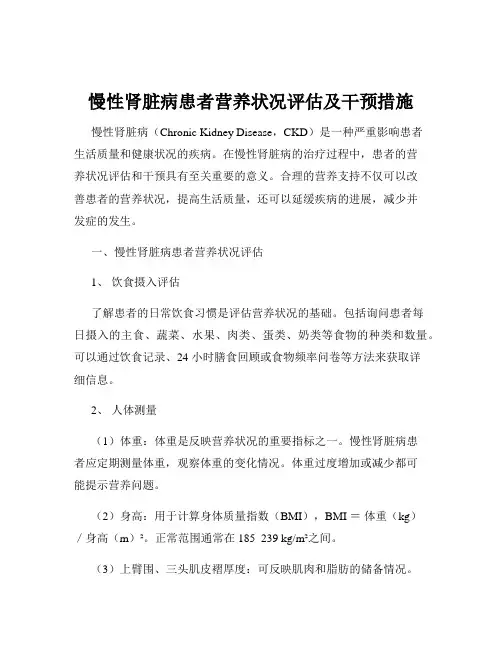
慢性肾脏病患者营养状况评估及干预措施慢性肾脏病(Chronic Kidney Disease,CKD)是一种严重影响患者生活质量和健康状况的疾病。
在慢性肾脏病的治疗过程中,患者的营养状况评估和干预具有至关重要的意义。
合理的营养支持不仅可以改善患者的营养状况,提高生活质量,还可以延缓疾病的进展,减少并发症的发生。
一、慢性肾脏病患者营养状况评估1、饮食摄入评估了解患者的日常饮食习惯是评估营养状况的基础。
包括询问患者每日摄入的主食、蔬菜、水果、肉类、蛋类、奶类等食物的种类和数量。
可以通过饮食记录、24 小时膳食回顾或食物频率问卷等方法来获取详细信息。
2、人体测量(1)体重:体重是反映营养状况的重要指标之一。
慢性肾脏病患者应定期测量体重,观察体重的变化情况。
体重过度增加或减少都可能提示营养问题。
(2)身高:用于计算身体质量指数(BMI),BMI =体重(kg)/身高(m)²。
正常范围通常在 185 239 kg/m²之间。
(3)上臂围、三头肌皮褶厚度:可反映肌肉和脂肪的储备情况。
3、生化指标检测(1)血清白蛋白:白蛋白是反映蛋白质营养状况的常用指标。
慢性肾脏病患者由于蛋白丢失、合成减少等原因,容易出现低蛋白血症。
(2)前白蛋白:其半衰期较短,能更敏感地反映近期的营养状况变化。
(3)血清肌酐、尿素氮:可反映肾功能,但也在一定程度上反映了蛋白质的摄入和代谢情况。
(4)电解质:如钾、钠、钙、磷等,慢性肾脏病患者容易出现电解质紊乱,影响营养状况。
4、主观全面评定(Subjective Global Assessment,SGA)这是一种综合评估方法,包括对患者的体重变化、饮食摄入、消化功能、肌肉消耗、皮下脂肪减少等方面进行主观评价,以判断营养状况。
二、慢性肾脏病患者营养状况不良的原因1、蛋白质代谢紊乱慢性肾脏病患者肾脏排泄功能下降,导致体内代谢废物蓄积,影响蛋白质的合成和代谢。
同时,为了减轻肾脏负担,患者需要限制蛋白质的摄入,容易导致蛋白质营养不良。
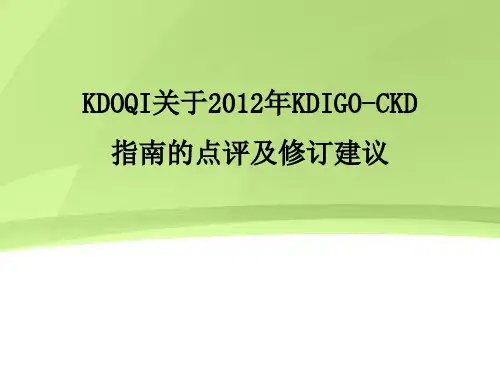
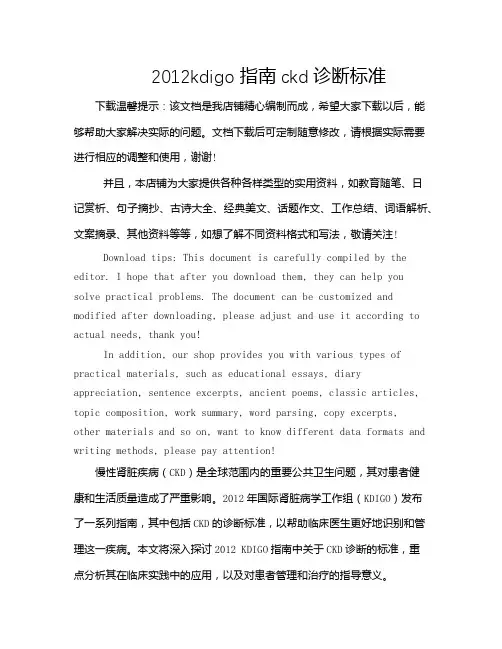
2012kdigo指南ckd诊断标准下载温馨提示:该文档是我店铺精心编制而成,希望大家下载以后,能够帮助大家解决实际的问题。
文档下载后可定制随意修改,请根据实际需要进行相应的调整和使用,谢谢!并且,本店铺为大家提供各种各样类型的实用资料,如教育随笔、日记赏析、句子摘抄、古诗大全、经典美文、话题作文、工作总结、词语解析、文案摘录、其他资料等等,如想了解不同资料格式和写法,敬请关注!Download tips: This document is carefully compiled by the editor. I hope that after you download them, they can help yousolve practical problems. The document can be customized and modified after downloading, please adjust and use it according to actual needs, thank you!In addition, our shop provides you with various types of practical materials, such as educational essays, diary appreciation, sentence excerpts, ancient poems, classic articles, topic composition, work summary, word parsing, copy excerpts,other materials and so on, want to know different data formats and writing methods, please pay attention!慢性肾脏疾病(CKD)是全球范围内的重要公共卫生问题,其对患者健康和生活质量造成了严重影响。

改善全球肾脏病预后组织慢性肾脏病贫血指南(概要)2013-06-25 来源:中华内科杂志KDIGO 慢性肾脏病 CKD 肾脏病贫血2012年改善全球肾脏病预后组织( KDIGO)制定了慢性肾脏病(CKD)贫血的临床实践指南,其目的在于为有贫血或具有贫血风险的所有CKD患者(非透析、透析、肾移植受者和儿童)提供诊断、评价、管理和治疗方面的指导。
指南的制订遵循了明确的证据审查和评价流程。
指南包含CKD贫血的诊断和评估、药物治疗[铁剂、红细胞生成刺激剂(ESA)和其他药物]和作为治疗手段的红细胞输注。
指南的各章节提出相应的治疗方法,其中的建议基于相关试验的系统评价。
根据GRADE(推荐、评估、发展、评价分级)系统评估证据质量和推荐强度。
本指南对目前证据的争议和局限性进行了探讨,也为今后的研究提供了更多的建议。
第一章慢性肾脏病(CKD)患者贫血的诊断与评估一、贫血检测(一)贫血检测频率1.无贫血的CKD患者(成人贫血定义参见本章二、贫血诊断中的1;儿童贫血定义参见本章二、贫血诊断中的2)符合下述临床指征时测定血红蛋白( Hb)浓度(未分级):CKD3期患者至少每年1次CKD4-5期非透析患者至少每年2次CKD5期血液透析(血透)和腹膜透析(腹透)患者至少每3个月1次2.伴有贫血但未行红细胞生成刺激剂(ESA)治疗的CKD患者符合下述临床指征时测定Hb浓度(未分级):CKD3~5期非透析患者和CKD5期腹透患者,至少每3个月1次CKD5期血透患者至少每月1次[参见第三章中六、Hb靶目标持续未达标或维持治疗失败的评估和纠正中(-)监测频率中的1-3,对正进行ESA治疗患者监测Hb浓度]二、贫血诊断1.成人CKD和>15岁儿童CKD患者贫血的诊断:男性Hb<13.0 g/dl (130 g/L)和女性Hb<12.0 g/dl (120g/L)。
(未分级)2.儿童CKD患者贫血的诊断:0.5~5岁儿童Hb<11.0 g/dl(110 g/L),5-12岁儿童Hb<11.5 g/dl(115g/L),12-15岁儿童Hb <12.0g/dl (120g/L)。
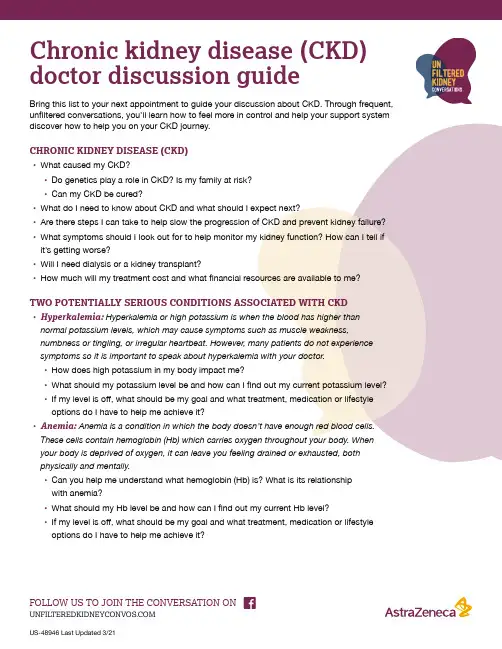
Chronic kidney disease (CKD) doctor discussion guideBring this list to your next appointment to guide your discussion about CKD. Through frequent, unfiltered conversations, you’ll learn how to feel more in control and help your support system discover how to help you on your CKD journey.CHRONIC KIDNEY DISEASE (CKD)• What caused my CKD?• Do genetics play a role in CKD? Is my family at risk?• Can my CKD be cured?• What do I need to know about CKD and what should I expect next?• Are there steps I can take to help slow the progression of CKD and prevent kidney failure? • What symptoms should I look out for to help monitor my kidney function? How can I tell if it’s getting worse?• Will I need dialysis or a kidney transplant?• How much will my treatment cost and what financial resources are available to me?TWO POTENTIALLY SERIOUS CONDITIONS ASSOCIATED WITH CKD• Hyperkalemia: Hyperkalemia or high potassium is when the blood has higher than normal potassium levels, which may cause symptoms such as muscle weakness, numbness or tingling, or irregular heartbeat. However, many patients do not experience symptoms so it is important to speak about hyperkalemia with your doctor.• How does high potassium in my body impact me?• What should my potassium level be and how can I find out my current potassium level?• If my level is off, what should be my goal and what treatment, medication or lifestyleoptions do I have to help me achieve it?• Anemia: Anemia is a condition in which the body doesn’t have enough red blood cells. These cells contain hemoglobin (Hb) which carries oxygen throughout your body. When your body is deprived of oxygen, it can leave you feeling drained or exhausted, both physically and mentally.• Can you help me understand what hemoglobin (Hb) is? What is its relationshipwith anemia?• What should my Hb level be and how can I find out my current Hb level?• If my level is off, what should be my goal and what treatment, medication or lifestyleoptions do I have to help me achieve it?weakness body aches chest pain headaches sleep problems trouble concentrating muscle pains or crampsother NOTES / ADDITIONAL QUESTIONS。
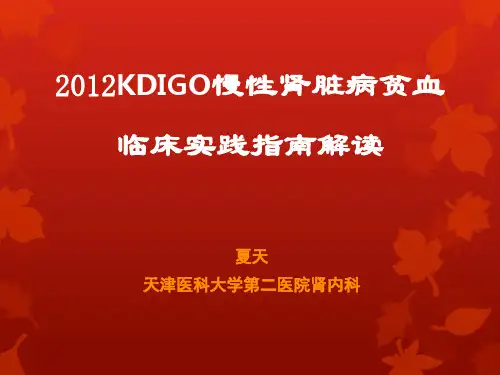
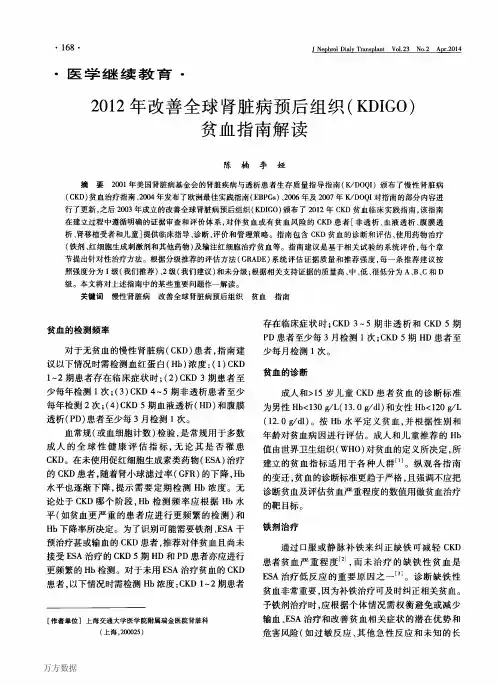
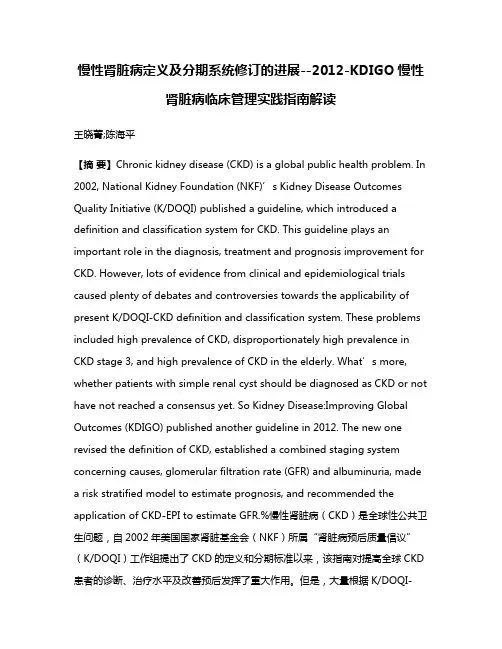
慢性肾脏病定义及分期系统修订的进展--2012-KDIGO慢性肾脏病临床管理实践指南解读王晓菁;陈海平【摘要】Chronic kidney disease (CKD) is a global public health problem. In 2002, National Kidney Foundation (NKF)’s Kidney Disease Outcomes Quality Initiative (K/DOQI) published a guideline, which introduced a definition and classification system for CKD. This guideline plays an important role in the diagnosis, treatment and prognosis improvement for CKD. However, lots of evidence from clinical and epidemiological trials caused plenty of debates and controversies towards the applicability of present K/DOQI-CKD definition and classification system. These problems included high prevalence of CKD, disproportionately high prevalence in CKD stage 3, and high prevalence of CKD in the elderly. What’s more, whether patients with simple renal cyst should be diagnosed as CKD or not have not reached a consensus yet. So Kidney Disease:Improving Global Outcomes (KDIGO) published another guideline in 2012. The new one revised the definition of CKD, established a combined staging system concerning causes, glomerular filtration rate (GFR) and albuminuria, made a risk stratified model to estimate prognosis, and recommended the application of CKD-EPI to estimate GFR.%慢性肾脏病(CKD)是全球性公共卫生问题,自2002年美国国家肾脏基金会(NKF)所属“肾脏病预后质量倡议”(K/DOQI)工作组提出了CKD的定义和分期标准以来,该指南对提高全球CKD 患者的诊断、治疗水平及改善预后发挥了重大作用。

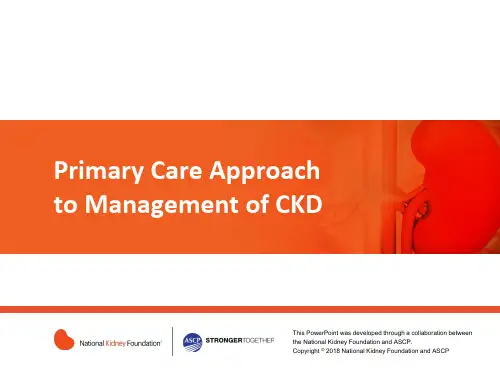
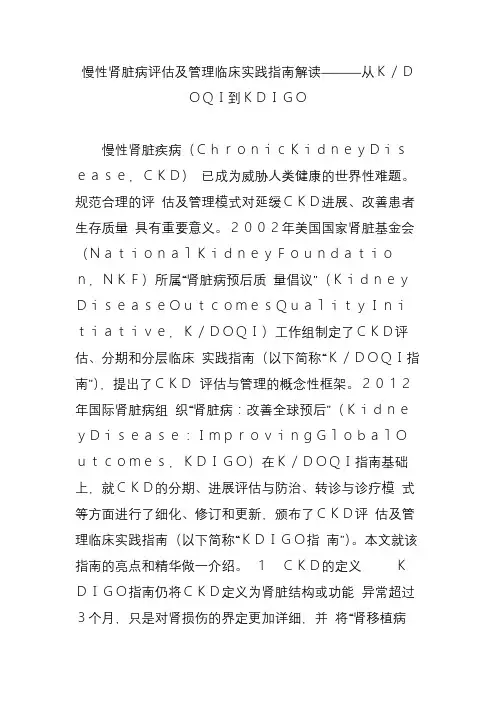
2012年KDIGO 慢性肾脏疾病血压管理临床实践指南解读赖玮婧,刘芳(四川大学华西医院 肾脏内科,成都 610041)通讯作者:刘芳 Email:liufangfh@【摘要】 合理的血压管理对延缓慢性肾脏疾病(CKD )进展具有重要意义。
美国国家肾脏基金会所属“肾脏病预后质量倡议”工作组基于2001年及以前的研究证据,于2004年发布了CKD 高血压及降压药临床实践指南。
国际肾脏病组织“肾脏病:改善全球预后”在该指南基础上增加了2012年2月及以前的证据,颁布了2012年KDIGO 慢性肾脏疾病血压管理临床实践指南。
本文就该指南的精华做一介绍。
【关键词】 慢性肾脏疾病;高血压;KDIGO ;KDOQI ;指南Interpretation of 2012 KDIGO Clinical Practice Guideline for the Management of Blood Pressure in Chronic Kidney DiseaseLAI Wei-jing, LIU Fang (Division of Nephrology, West China Hospital of Sichuan University, Chengdu 610041, China)Corresponding author: LIU Fang Email:liufangfh@【Abstract 】The blood pressure management is important for delaying the progression of chronic kidney disease (CKD). Based on the evidence collected up to 2001, the National Kidney Foundation (NKF) established the “Kidney Disease Outcomes Quality Initiative (KDOQI) Clinical Practice Guidelines on Hypertension and Antihypertensive Agents in Chronic Kidney Disease” in 2004. Based on the KDOQI guideline and evidence collected up to February 2012, the “Kidney Disease: Improving Global Outcomes (KDIGO) Clinical Practice Guideline for the Management of Blood Pressure in Chronic Kidney Disease” was then published in 2012. And we reviewed the essential parts of the guideline in this article.【Key words 】Chronic kidney disease; Hypertension; KDIGO; KDOQI; Guideline 慢性肾脏疾病(chronic kidney disease ,CKD )与高血压密切相关,两者互为因果,相互促进。
2012kdigo指南ckd诊断标准Chronic kidney disease (CKD) is a significant health issue affecting millions of people worldwide. The KDIGO (Kidney Disease: Improving Global Outcomes) guidelines provide essential information for the diagnosis and management of CKD. These guidelines are crucial for healthcare professionals in identifying and treating patients with this condition.慢性肾脏疾病(CKD)是影响全球数百万人的重要健康问题。
KDIGO(肾脏疾病:改善全球结果)指南为CKD的诊断和管理提供了重要信息。
这些指南对于医疗专业人员在识别和治疗患有这种疾病的患者方面至关重要。
One of the key aspects of the 2012 KDIGO guidelines concerning CKD diagnosis is the classification of the disease based on the level of kidney function and the presence of kidney damage. This classification system helps healthcare providers determine the severity of the disease and tailor treatment plans accordingly. By following these guidelines, healthcare professionals can ensure that patients receive appropriate care and interventions to slow the progression of CKD.2012 KDIGO指南关于CKD诊断的关键方面之一是根据肾功能水平和肾脏损伤的程度对疾病进行分类。